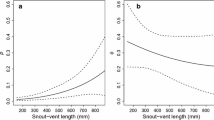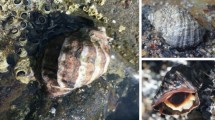Abstract
Understanding potential for range expansion is critical when evaluating the risk posed by invasive species. Burmese pythons (Python molurus bivittatus) are established in southern Florida and pose a significant threat to native ecosystems. Recent studies indicate that climate suitable for the species P. molurus exists throughout much of the southern United States. We examined survivorship, thermal biology, and behavior of Burmese pythons from South Florida in a semi-natural enclosure in South Carolina, where winters are appreciably cooler than in Florida, but within the predicted region of suitable climate. All pythons acclimated to the enclosure, but most died after failing to seek appropriate refugia during sub-freezing weather. The remaining snakes used refugia but died during an unusually cold period in January 2010. Although all snakes died during the study, most survived extended periods at temperatures below those typical of southern Florida and none exhibited obvious signs of disease. Our study represents a first step in evaluating the results of climate matching models and we address factors that may affect range expansion in this invasive species.




Similar content being viewed by others
References
Andrewartha HG, Birch LC (1954) The distribution and abundance of animals. University of Chicago Press, Chicago
Angiletta MJ, Niewiarowski PH, Navas CA (2002) The evolution of thermal physiology in ectotherms. J Therm Biol 27:249–268
Aubret F, Shine R (2010) Thermal plasticity in young snakes: how will climate change affect the thermoregulatory tactics of ectotherms? J Exp Biol 213:242–248
Avery RA (1982) Field studies of body temperatures. In: Gans C, Pough FH (eds) Biology of the reptilia, vol 12. Academic Press, New York, pp 93–166
Avery ML, Engeman RM, Keacher KL, Humphrey JS, Bruce WE, Mathies TC, Mauldin RE (2010) Cold weather and the potential range of introduced Burmese pythons. Biol Invas (in press)
Ayrinhac A, Debat V, Gibert P, Kister A, Legout H, Moreteau B, Vergilino R, David J (2004) Cold adaptation in geographical populations of Drosophila melanogaster: phenotypic plasticity is more important than genetic variability. Funct Ecol 18:700–706
Barker DG, Barker TM (2010) Review: giant constrictors: biological and management profiles and an establishment risk for nine large species of pythons, anacondas, and the boa constrictor by Robert N. Reed and Gordon H. Rodda 2009. U.S. Geological Survey Open-File Report 2009-1202, xviii+302 pp. Bull Chicago Herp Soc 45:1–8
Bertoli CI, Scannapieco AC, Sambucetti P, Norry FM (2010) Direct and correlated responses to chill-coma recovery selection in Drosophila buzzatii. Entomologia Experimentalis Et Applicata 134:154–159
Bhupathy S, Vijayan VS (1989) Status, distribution and general ecology of the Indian Python, Python molurus molurus Linn. in Keoladeo National Park, Bharatpur, Rajasthan. J Bombay Nat Hist Soc 86:381–387
De Vosjoli P, Klingenberg R (2005) Burmese pythons: plus reticulated pythons and related species. Advanced Vivarium Systems, Laguna Hills
Groombridge B, Luxmoore R (1991) Pythons in South-east Asia. A review of distribution, status, and trade in three selected species. Report to Cites Secretariat, Lausanne
Hoffmann AA, Weeks AR (2007) Climatic selection on genes and traits after a 100 year-old invasion: a critical look at the temperate-tropical clines in Drosophila melanogaster from eastern Australia. Genetica 129:133–147
Hoffmann AA, Anderson A, Hallas R (2002) Opposing clines for high and low temperature resistance in Drosophila melanogaster. Ecol Lett 5:614–618
Holbrook J, Chesnes T (2010) An effect of Burmese pythons (Python molurus bivittatus) on mammal populations in southern Florida. Florida Sci (in press)
Huey RB (1982) Temperature, physiology, and the ecology of reptiles. In: Gans C, Pough FH (eds) Biology of the reptilia, vol 12. Academic Press, New York, pp 25–91
Kabela E (2009) Savannah River Site annual meteorology report. SRNL-RP-2009-00251
Kraus F (2009) Alien reptiles and amphibians: a scientific compendium and analysis. Springer, New York
Lee JR, Mills MS (2000) Design and construction of an outdoor enclosure for the study of snake thermal ecology. Herpetol Rev 31:24–26
Mazzotti FJ, Cherkiss MS, Hart KM, Snow S, Rochford MR, Dorcas ME, Reed R (2010) Cold-induced mortality of invasive Burmese pythons in south Florida. Biol Invas (in press)
Peterson CR, Gibson AR, Dorcas ME (1993) Snake thermal ecology: the causes and consequences of body-temperature variation. In: Seigel RA, Collins JT (eds) Snakes: ecology and behavior. McGraw-Hill, New York, pp 241–314
Pimentel D, Zuniga R, Morrison D (2000) Environmental and economic costs of nonindigenous species in the United States. Bioscience 50:53–65
Pyron RA, Burbrink FT, Guiher TJ (2008) Claims of potential expansion throughout the U.S. by invasive python species are contradicted by ecological niche models. PLoS ONE 3:e2931
Reed RN (2005) An ecological risk assessment of nonnative boas and pythons as potentially invasive species in the United States. Risk Anal 25:753–766
Reed RN, Rodda GH (2009) Giant constrictors: biological and management profiles and an establishment risk assessment for nine large species of pythons, anacondas, and the boa constrictor. U.S. Geological Survey Open-File Report 2009–1202
Reinert HK, Cundall D (1982) An improved surgical implantation method for radio-tracking snakes. Copeia 1982:702–705
Rodda GH, Jarnevich CS, Reed RN (2009) What parts of the US mainland are climatically suitable for invasive alien pythons spreading from Everglades National Park? Biol Invas 11:241–252
Sakai AK, Allendorf FW, Holt JS, Lodge DM, Molofsky J, With KA, Baughman S, Cabin RJ, Cohen JE, Ellstrand NC, McCuley DE, O’Neil P, Parker IM, Thompson JN, Weller SG (2001) The population biology of invasive species. Ann Rev Ecol Syst 32:305–332
Snow RW, Krysko KL, Enge KM, Oberhofer L, Warren-Bradley A, Wilkins L (2007) Introduced populations of Boa constrictor (Boidae) and Python molurus bivittatus (Pythonidae) in southern Florida. In: Henderson RW, Powell R (eds) Biology of the boas and pythons. Eagle Mountain Publishing, Eagle Mountain, pp 416–438
Stohlgren TJ, Jarnevich CS (2009) Risk assessment of invasive species. In: Clout MN, Williams PA (eds) Invasive species management: a handbook of principles and techniques. Oxford University Press, Oxford, pp 19–46
Storey KB, Storey JM (1992) Natural freeze tolerance in ectothermic vertebrates. Ann Rev Physiol 54:619–637
Whitaker R, Captain A (2004) Snakes of India: the field guide. Draco Books, Chengalpattu
Wilson M, Echternacht AC (1987) Geographic variation in the critical thermal minimum of the green anole, Anolis carolinensis (Sauria: Iguanidae), along a latitudinal gradient. Comp Biochem Physiol A 87:757–760
Zhao E, Adler K (1993) Herpetology of China. Society for the Study of Amphibians and Reptiles, St. Louis
Acknowledgments
We thank R. Bauer and S. Poppy for assisting with many aspects of the study and helping to track snakes. For assistance with various project logistics and advice, we thank K. Andrews, M. Cherkiss, B. DeGregorio, J. Greene, C. Hagen, K. Hart, E. Kabela, F. Mazzotti, T. Mills, S. Pfaff, M. Pilgrim, M. Rochford, S. Snow, T. Tuberville, A. Tucker, T. Walters, and A. Wolfe. R. Snow provided and transported animals. We especially thank R. McManamon and B. Ritchie from the Univ. of Georgia School of Veterinary Medicine who conducted necropsies. E. Eskew assisted with calibrating dataloggers. S. Foley assisted with data analysis. E. Eskew, S. Price, K. Hart, R. Reed, R. Snow, and two anonymous reviewers all provided comments on the manuscript. All procedures used in the study were approved by the University of Georgia Animal Care and Use Committee (no. A2009 2-041). Pythons were collected under scientific collecting permit #EVER-2009-SCI-0001 issued by the NPS. This material is based upon work supported by the US Dept. of Energy under Award Number DE-FC-09-075R22506 to the University of Georgia’s Savannah River Ecology Lab. Partial funding was provided by the Davidson College Department of Biology and Duke Power.
Author information
Authors and Affiliations
Corresponding author
Rights and permissions
About this article
Cite this article
Dorcas, M.E., Willson, J.D. & Gibbons, J.W. Can invasive Burmese pythons inhabit temperate regions of the southeastern United States?. Biol Invasions 13, 793–802 (2011). https://doi.org/10.1007/s10530-010-9869-6
Received:
Accepted:
Published:
Issue Date:
DOI: https://doi.org/10.1007/s10530-010-9869-6




